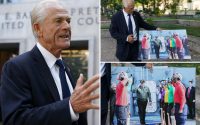Inside the Oppenheimer nuclear test site which gave birth to the atomic bomb
The Trinity nuclear test site is an eerily silent place.
The area, in the desolate New Mexico desert, is where Robert J. Oppenheimer and his team changed the course of history by detonating the world’s first atomic bomb — the deadliest and most destructive weapon ever deployed, which helped end World War II.
The Trinity site, named after the nuclear project’s codename, is usually closed to the public, but the US military granted The Post exclusive access for one morning following renewed interest in the historic area spurred by the summer blockbuster about Oppenheimer’s life by Christopher Nolan.
The fenced-in site includes the “ground zero” where the bomb was detonated, leaving behind a 100-foot-wide and 10-foot-deep crater, about 60 miles north of White Sands National Park.
“The first atomic bomb was detonated up above that point on a steel tower that the bomb vaporized, so all that’s left now is one of the footings of that tower,” said Drew Hamilton, US Army Public Affairs Specialist for White Sands Missile Range.
The ground zero is behind locked gates, with only an obelisk marking where the plutonium device, named “Gadget,” released 18.6 kilotons of power, creating the infamous mushroom cloud seared into the world’s collective consciousness.

Littering the site are shards of green speckled glass-type objects — called Trinitite, after the test area — that were created by the sheer force of the bomb when it was detonated on July 16, 1945.
When the bomb went off, sand from the desert floor was sucked into its blast and “it was actually blown up into the fireball of the explosion, melted there and rained back down,” Hamilton explained, adding Trinitite was found miles away after the explosion.
As well as green Trinitite there are also red and black variations, which are much rarer, but sometimes found near the test area. Due to its radioactive nature, the US atomic energy commission bulldozed and buried most of it in 1953.


Hamilton added the Trinitite is the most commonly stolen thing from the site — which is illegal. Although still technically radioactive, it is not harmful.
In fact the whole site is still nominally radioactive, but exposure is lower than what you would get from eating a banana, the Army said, insisting it’s “perfectly safe.”
“We’ve had all kind of things from people coming out in full suits and masks, people taking their shoes and just leaving them in the parking lot. Please don’t do that,” Hamilton laughed.

Also on the site is the Schmidt-McDonald Ranch House, where the Gadget bomb’s plutonium core was assembled, and the base camp where those involved in the project lived.
Nolan, whose drama “Oppenheimer” has already grossed over $649 million worldwide, traveled to the Trinity Site in preparation for the movie.
“He brought a whole crew out here, location scouting, and they spent the better part of the day driving around visiting Trinity Site ground zero, the ranch house, as well as locations that are not part of the tour,” he added.

The results of the Trinity tests led to the first and only time nuclear weapons have ever been deployed, when the US dropped atomic bombs on the cities of Hiroshima and Nagasaki in August 1945 — killing between 129,000 and 226,000 mostly civilians and forcing Japan’s surrender.
The site opens to the public free of charge twice in year — in April and October.
Hamilton disclosed Japanese tourists are among the most interested in the site, outside of American visitors.

“As far as its meaning, as far as whether it was a good thing or a bad thing, we prefer to leave that up to the individual visitor to decide,” Hamilton said.
But the most remarkable thing about the visit is what it makes people think about rather than what they see.
“There isn’t a whole lot here; there’s not a lot to do, this isn’t an amusement park… but this is the place where the door to the atomic age was kicked open,” Hamilton said. “Once this happened, there was no denying that the world was not going back.”
The general public is only allowed to access Trinity Site twice a year because the rest of the time, missile testing is being conducted around the historical landmark.
“White Sands Missile Range primarily tests missile technology, whether that be air defense or surface-to-surface,” the Army spokesman said. “We also support NASA almost once a month.”

Hamilton was not authorized to disclose more details of what gets tested at the Army facility, but during The Post’s visit, tanks could be seen driving in the distance, as well as construction of bunkers for future testing.
The site is preparing for a huge influx at its next visitation date on October 21 — because of the movie. Hamilton says they are preparing for even more people than in 2015 for the 70th anniversary of the tests when 5,000 people turned up.
“We’ve upgraded all of our facilities,” said Hamilton. “We are prepared to handle more than 5,000 per visit these days, which is good because I think in October we’re going to get a lot more than that.”


